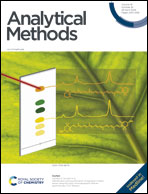Study on the affinity sites of cadmium's binding to ligands by thermodynamics and nuclear magnetic resonance spectroscopy†
Abstract
The affinity sites of cadmium (Cd(II)) when binding to cysteine (Cys) and glutathione (GSH) were studied via thermodynamics and nuclear magnetic resonance (NMR) spectroscopy methods. The results showed that the Cd(II) binding sites of Cys and GSH were –SH (exothermic), –NH2 (endothermic) and –COOH (endothermic). The thermodynamic behaviour of Cd(II) binding to Cys/GSH in boric acid and HEPES buffers differed, with the former being mainly endothermic and the latter mainly exothermic. It could be inferred that, in the boric acid system, the main binding site of Cd(II) with Cys and GSH is changed from –SH in HEPES to –COOH and –NH2 in boric acid. This was confirmed by the results of NMR experiments of Cd(II) with Cys/GSH. 1D 1H-NMR experiments showed that, after the combination of Cd(II) and Cys, the changes in the chemical shifts and peak strengths of protons near the –SH group for the reaction in HEPES were greater than when boric acid buffer was used. Changes in the chemical shift and peak strength of the –NH2 protons due to the binding of Cd(II) to GSH were evident in the boric acid buffer but not in HEPES. The screening of functional monomers is very important in the process of preparation of cadmium ion-imprinted materials. This research provides important theoretical and experimental guidance for the screening of functional monomers.



 Please wait while we load your content...
Please wait while we load your content...